Its required to write Java code of GIU application that do the below functions explained in pictures. GUI will be only one frame
objective is to implement a program to understand the memory deficits of the clinical cases. Memory Deficit is divided into two parts as Alzheimer and Amnesia. Alzheimer and Amnesia are all memory deficits. Each has its own patient/s or we can just call them as clinical cases.
Relationships between classes: There is an IS-A Relationship between the classes MemoryDeficit, Alzheimer and Amnesia that can be seen from the class diagram. There is a HAS-A Relationship between Alzheimer and ClinicalCase classes and a HAS-A Relationship between Amnesia and ClinicalCase classes Implement your classes according to these important notifications given above. Some information related with classes: For all non-visual classes, there is no default value for the non-static data members. Write only the necessary accessor and mutator methods inside the classes!! You may add methods other than the given ones, IF you are going to use them!! toString() method for all the classes: will return the necessary data field information related with the implemented class. improveMemory() method is overridden in child classes (Alzheimer and Amnesia). For Alzheimer, it returns Solve Sudoku puzzles! For Amnesia, it returns Look old photos!. PART B: Implement your GUI!! Create a frame in your project named as MemoryApp. Frame-1: This frame is the default start up frame. At first, users will enter the id of the deficit and choose the type of the memory loss from the combo box. Then, the user will enter the information of the clinical cases representing the patients. Be careful while entering the name and surname of the patient. Do not forget to separate them by using comma (,) after getting from the user. The deficit type divided into two parts as Amnesia and Alzheimer. Use radio buttons to differentiate them and to open related panels. You may use different number of panels, however do not forget to implement the ones which have the titled border. User cannot edit text areas
Figure -2 and 3: Enter the necessary information, choose the radio button Amnesia in order to enter information about this type of memory deficit. ADD DEFICIT button for Amnesia: When the user presses ADD DEFICIT button, the information about the memory deficit Amnesia must be kept from the necessary components. You will create an Amnesia object with using these information. Then, you will add that object into the InfoClasss ArrayList without creating an InfoClass Object (try to use InfoClasss addMemory method). Also before the add operation ended, all the necessary text fields must be cleared and the combo box values must be appeared as empty just like the opening frame. The added Amnesia must be send to the first text area as a message of Amnesia is added. The value of the deficit id will be sent to another combo box at the right side of the frame, next to the Search by deficit id button. BE CAREFUL; USE ONLY ONE ARRAYLIST which blongs to the InfoClasss static one for holding memory deficit information. DO NOT TRY to separate them into two array lists.
Figure -4 and 5: Enter the necessary information; choose the radio button Alzheimer in order to enter information about this type of memory deficit. ADD DEFICIT button for Alzheimer: When the user presses ADD DEFICIT button, the information about the memory deficit Alzheimer must be kept from the necessary components. You will create an Alzheimer object with using these information. Then, you will add that object into the InfoClasss ArrayList without creating an InfoClass Object (try to use InfoClasss addMemory method). Also before the add operation ended, all the necessary text fields must be cleared and the combo box values must be appeared as empty just like the opening frame. The added Alzheimer must be send to the first text area as a message of Alzheimer is added. 5 The value of the deficit id will be sent to another combo box at the right side of the frame, next to the Search by deficit id button.
Display Deficit button: in order to display information about the memory deficit types use Display Deficit button. You are supposed to use InfoClasss getAllMemory() method. Use radio buttons to differentiate the memory deficit types. If the user selects Amnesia radio button and presses the Display Deficit button, all the information about this deficit type will be displayed. You are supposed to use InfoClasss static getAmnesia() method to do this.
If the user selects Alzheimer radio button and presses the Display Deficit button, all the information about this deficit type will be displayed. You are supposed to use InfoClasss static getAlzheimer() method to do this. Be careful, display deficit button will display all the amnesia information or all the Alzheimer information hold in the array list.
Total Deficits button: When the user presses Total Deficits button, in the second text area the information about the total numbers of Total Deficits, Total Amnesics and Total Alzheimers will be appeared. You are supposed to use InfoClasss showTotalMemory() method which calls the MemoryDeficit classs static method of getTotalDeficit(). If you need similar static methods for the other total values, add them too. Since, we just entered two information, the number of Total Deficits is 2, Total Amnesics is 1 and the number of Total Alzheimers is 1. For every added memory deficit whether Amnesia or Alzheimer, the values here must be increment.
Search by deficit id button: The users can search both memory deficit types by using the deficit ids. Your search process will be done by InfoClasss static method of searchMemory() which requires a string id as a parameter. When the user selects an id from the combo box and presses the Search by deficit id button, the information about that deficit, should appear in the text area.
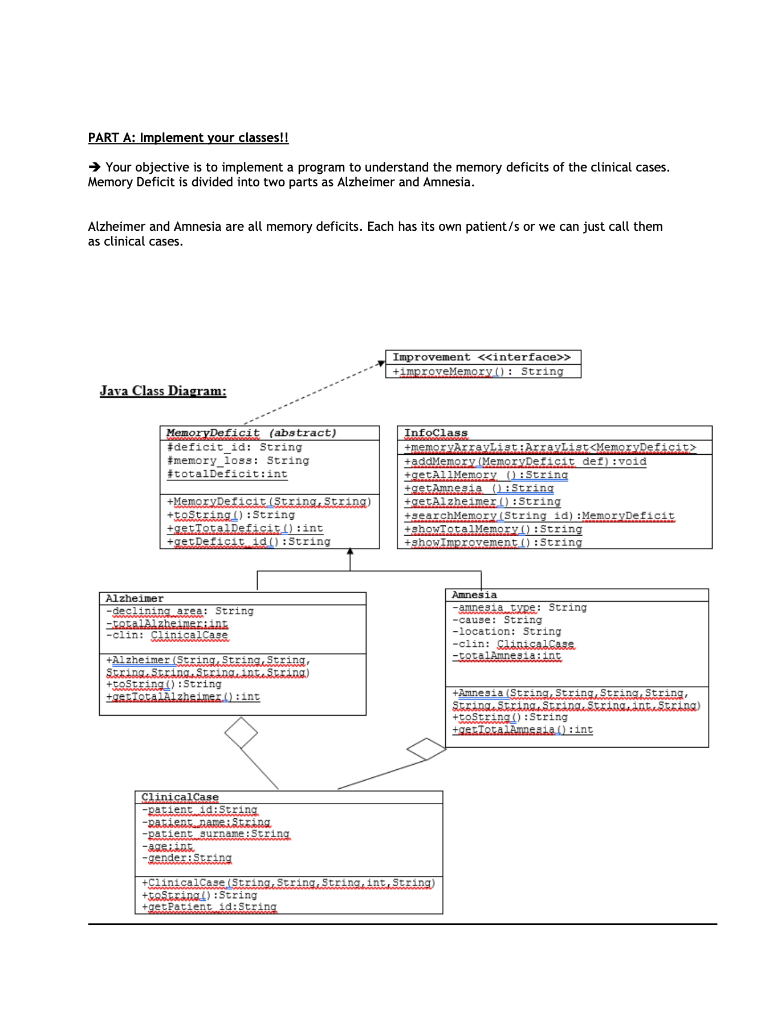
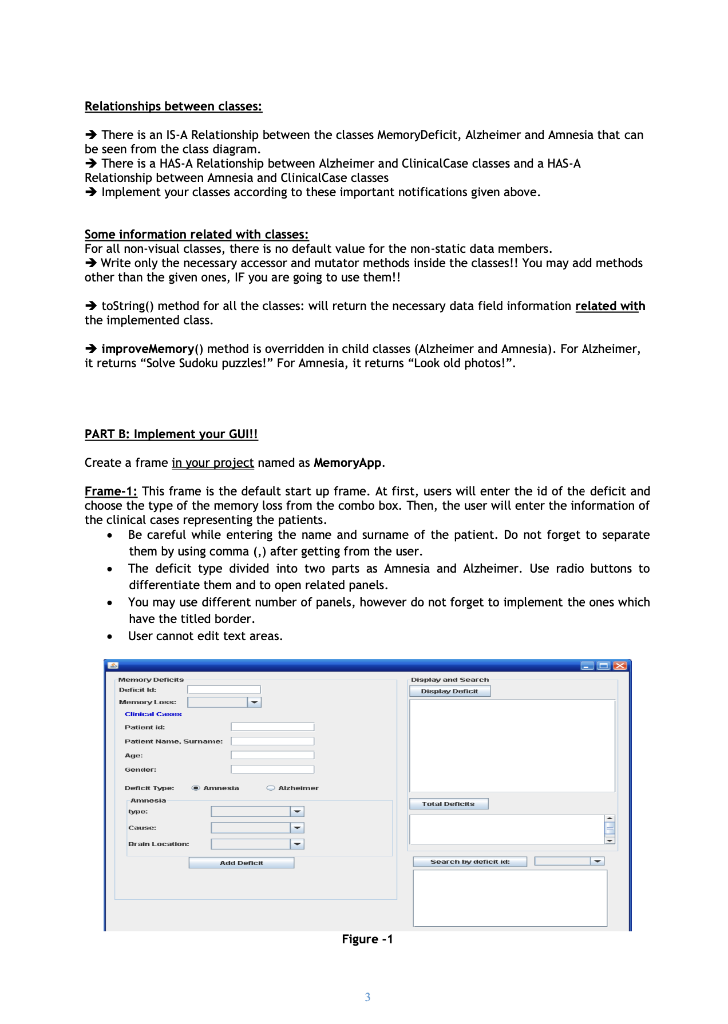
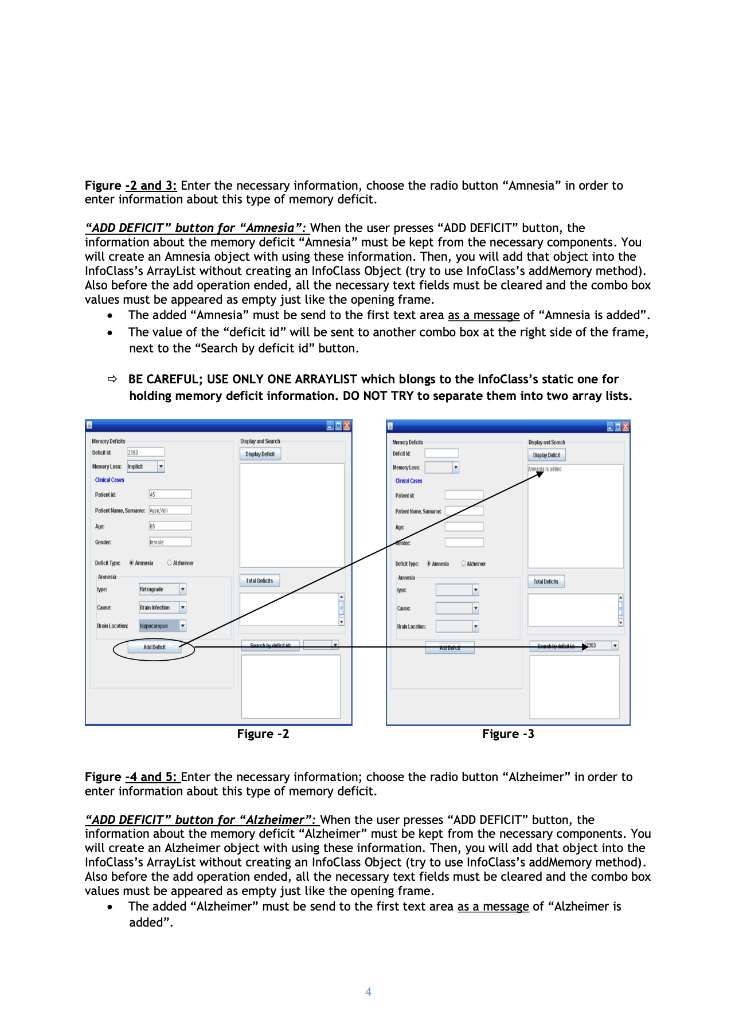
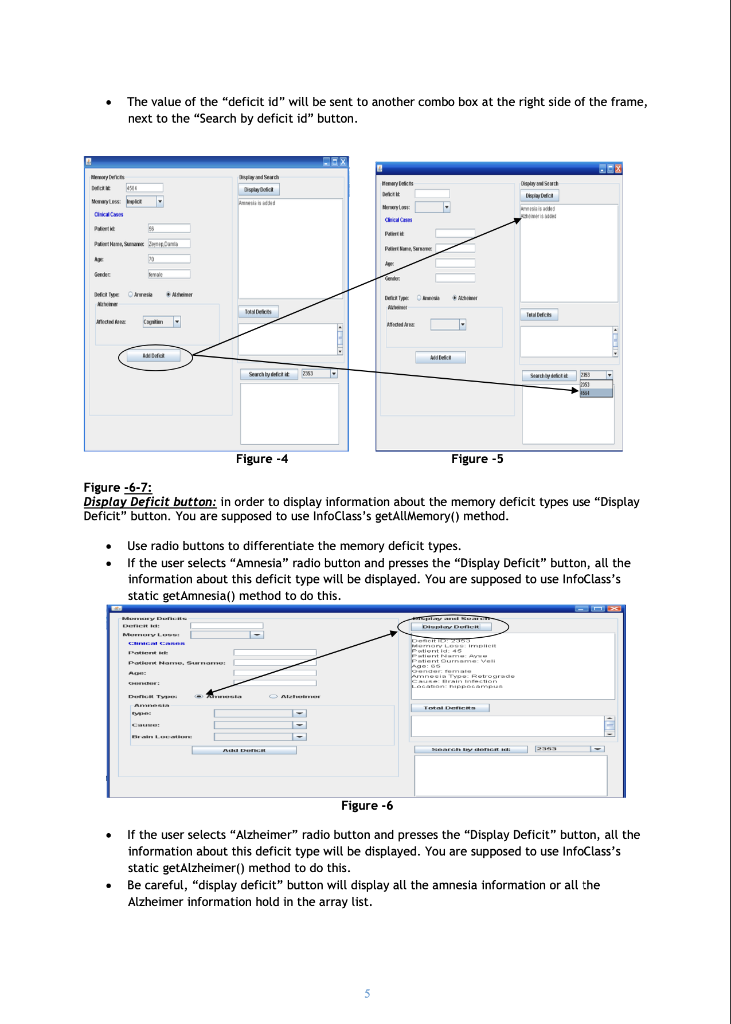
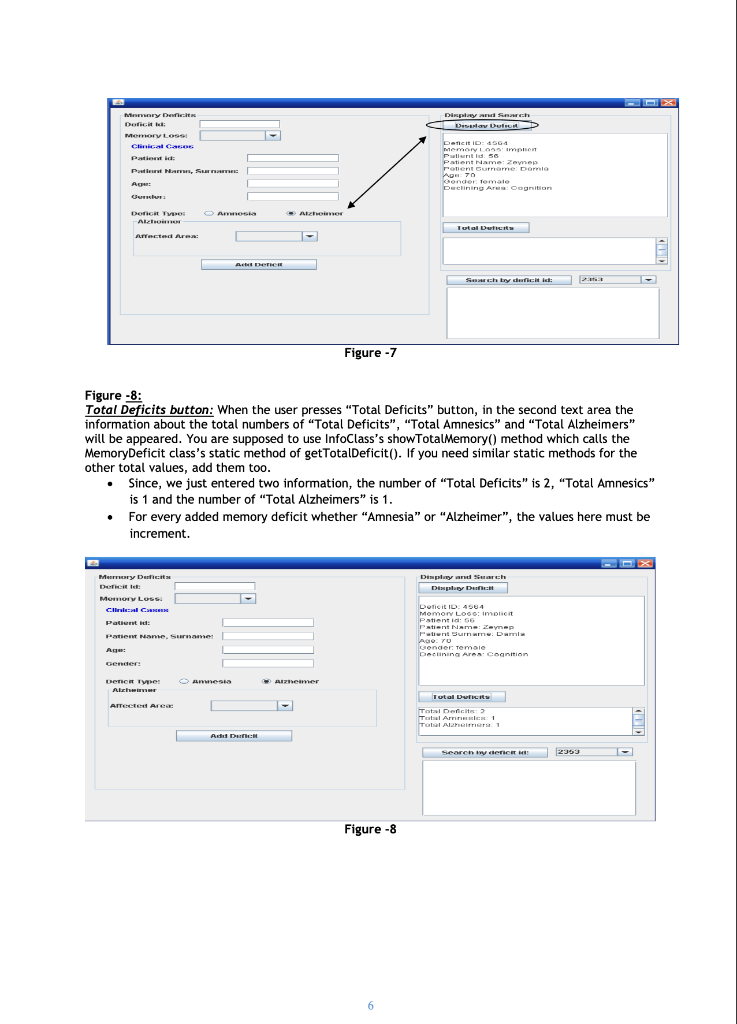
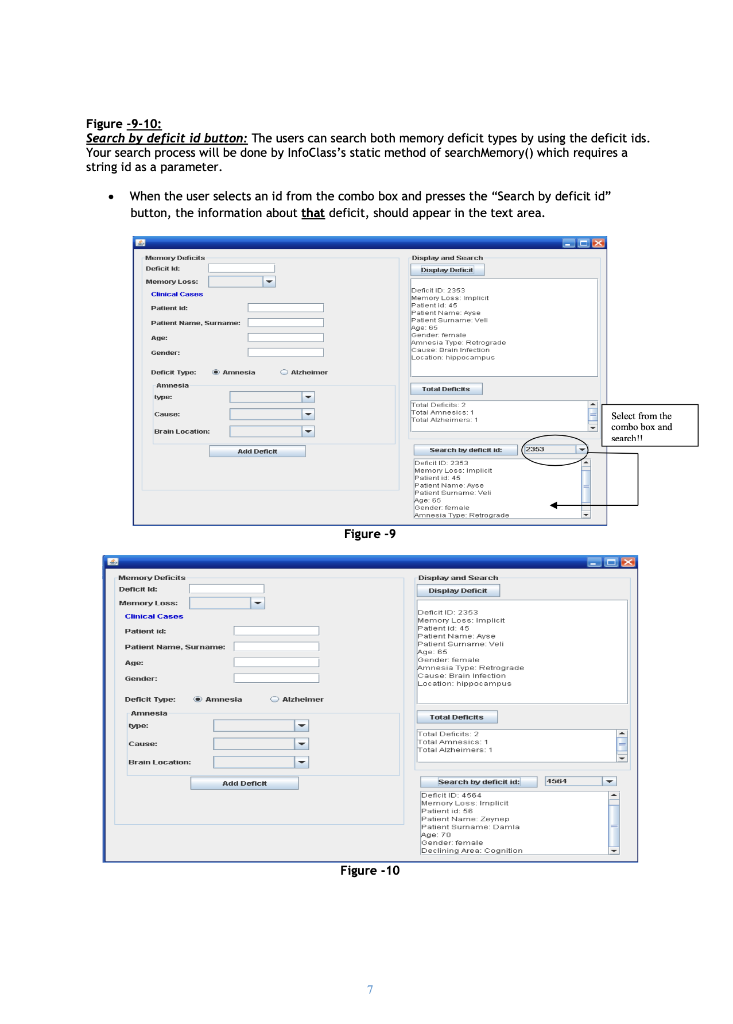
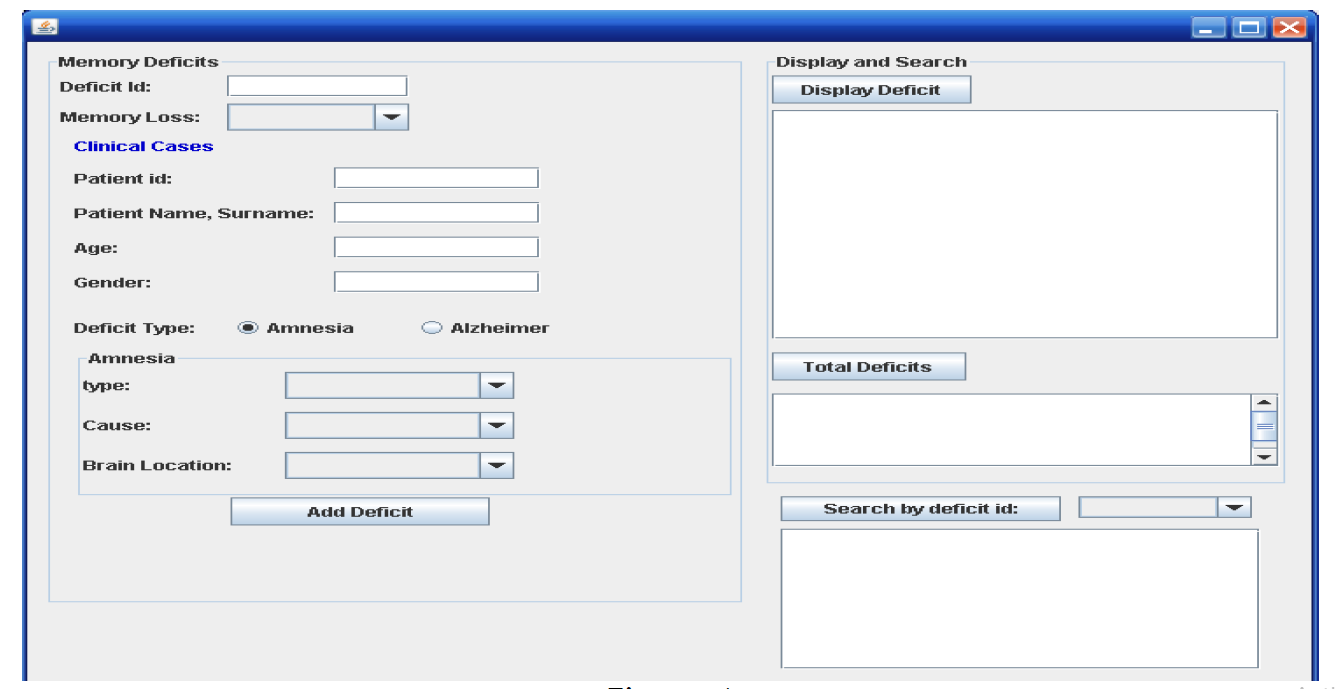
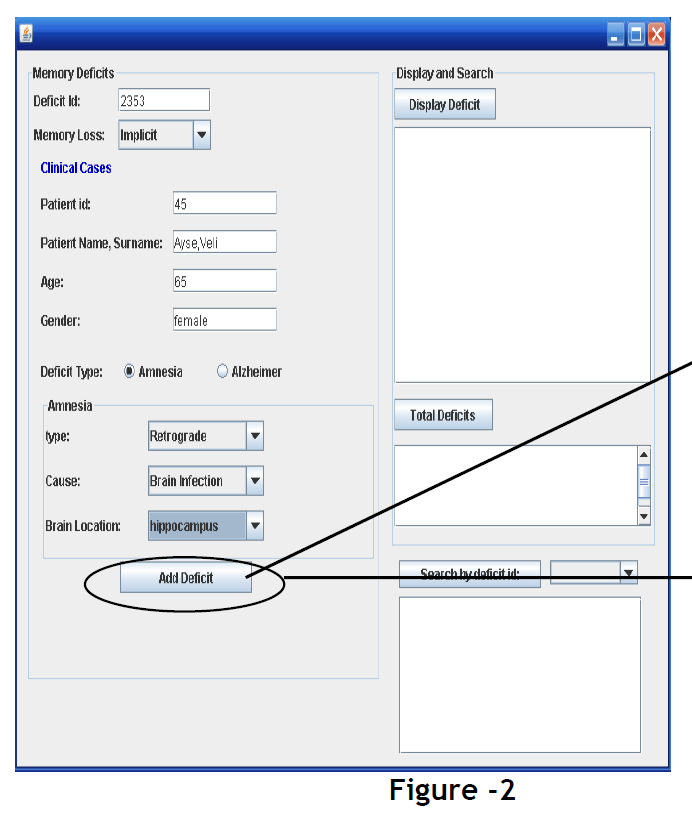
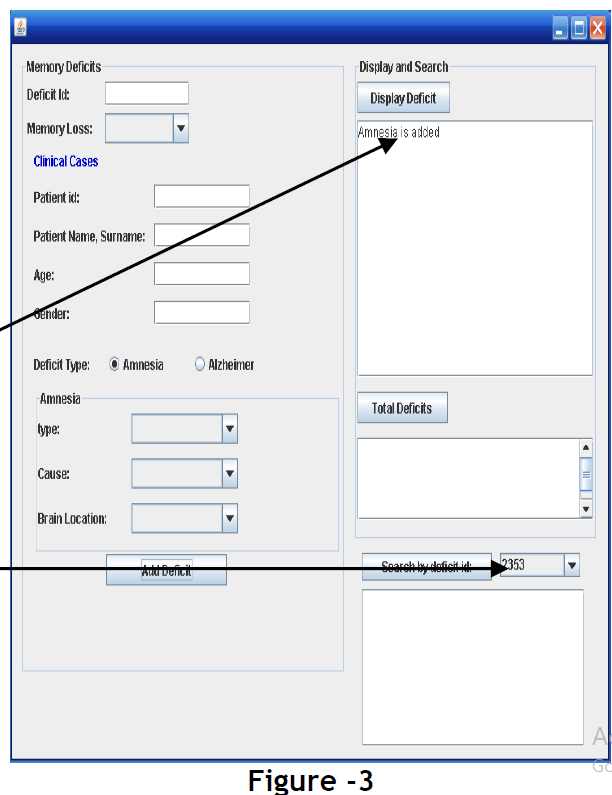
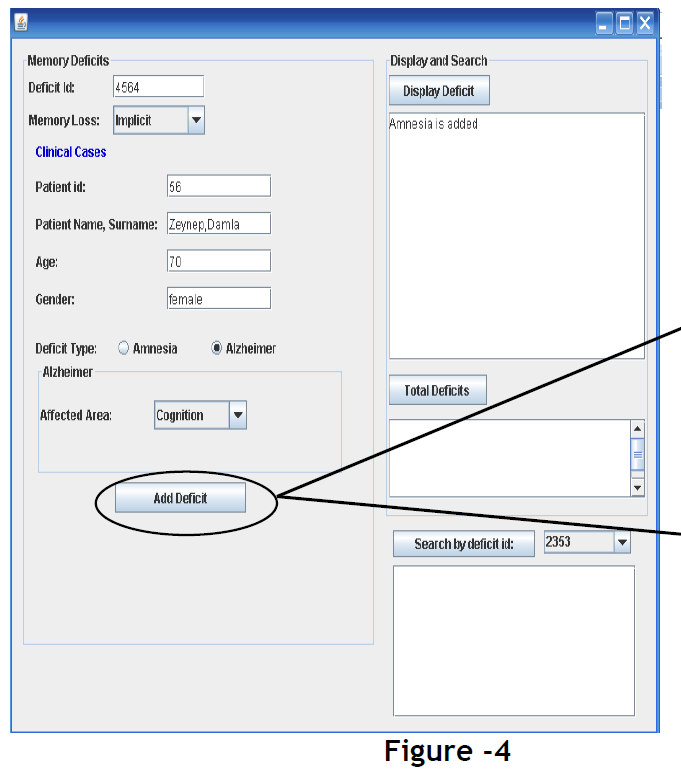
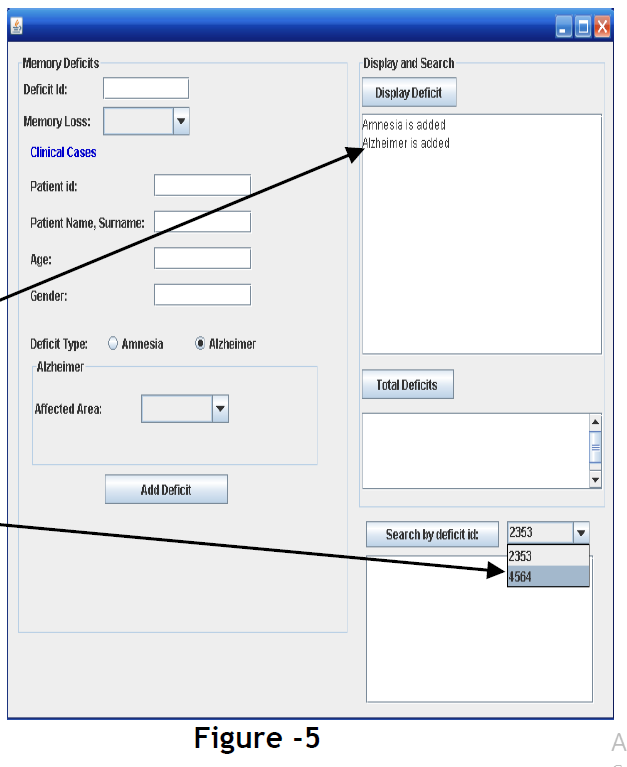
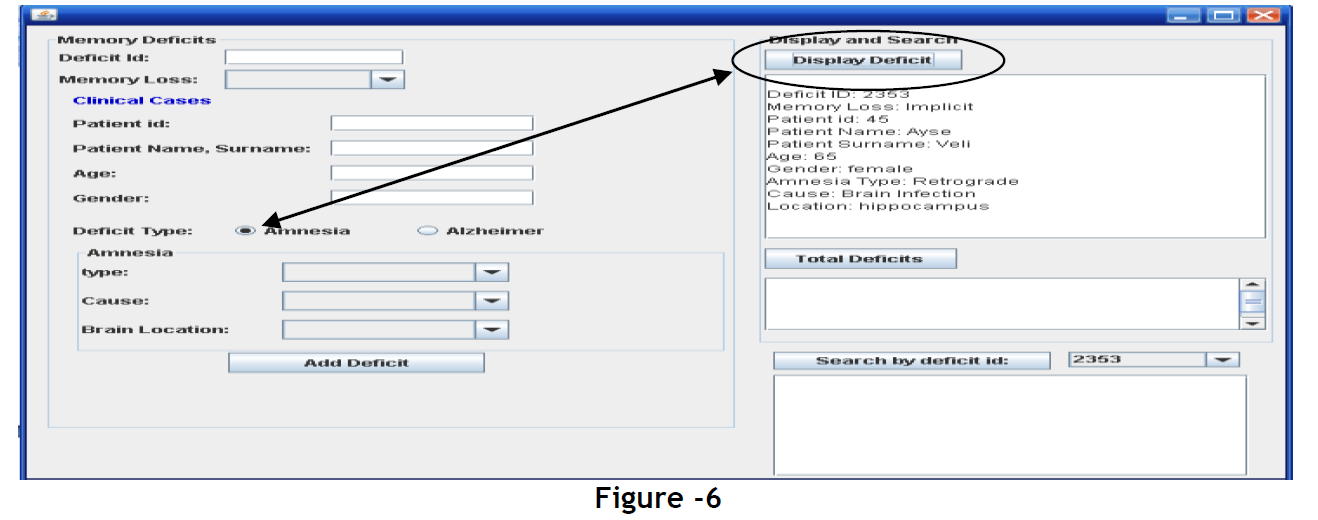
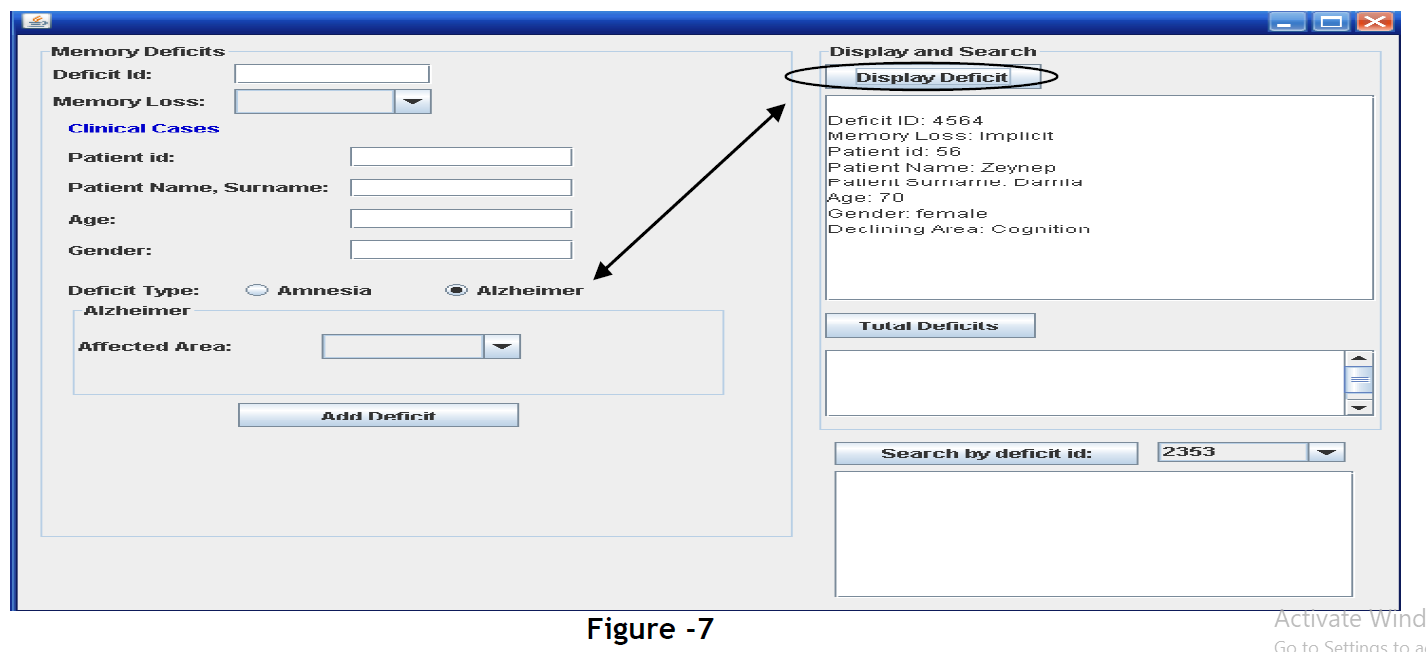
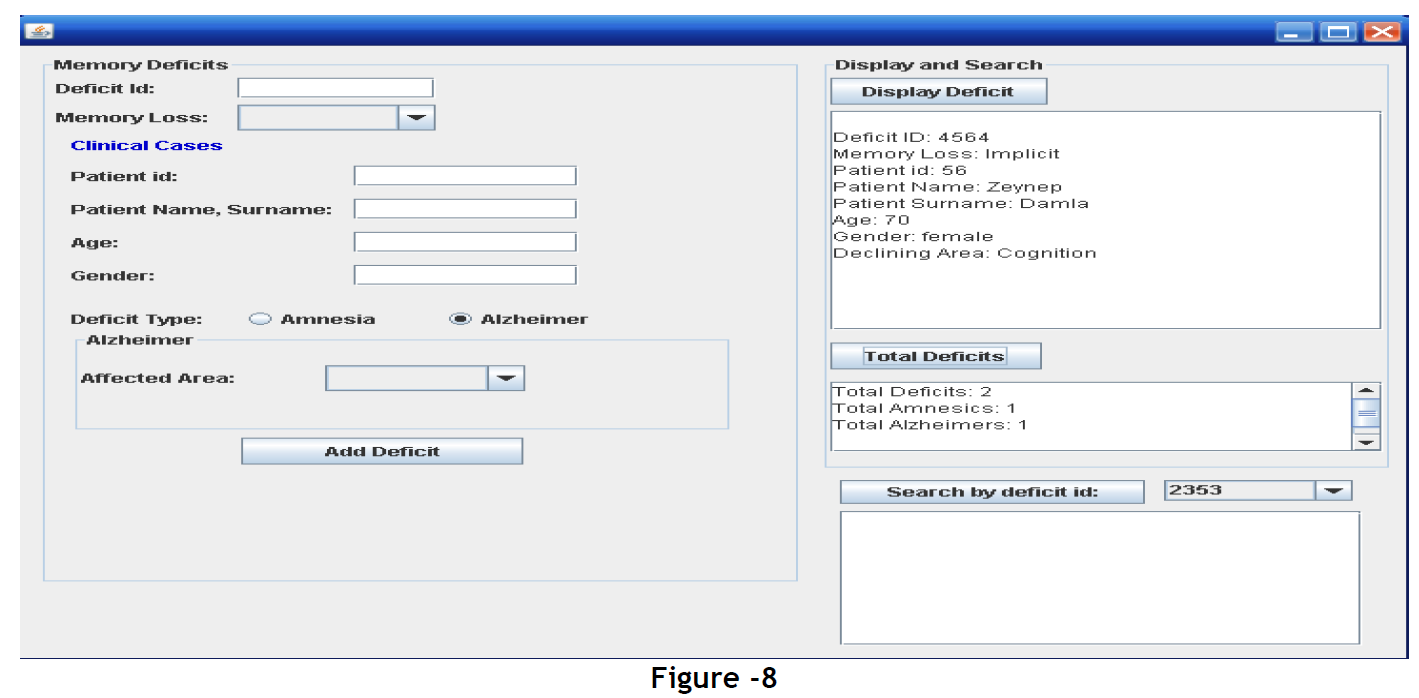
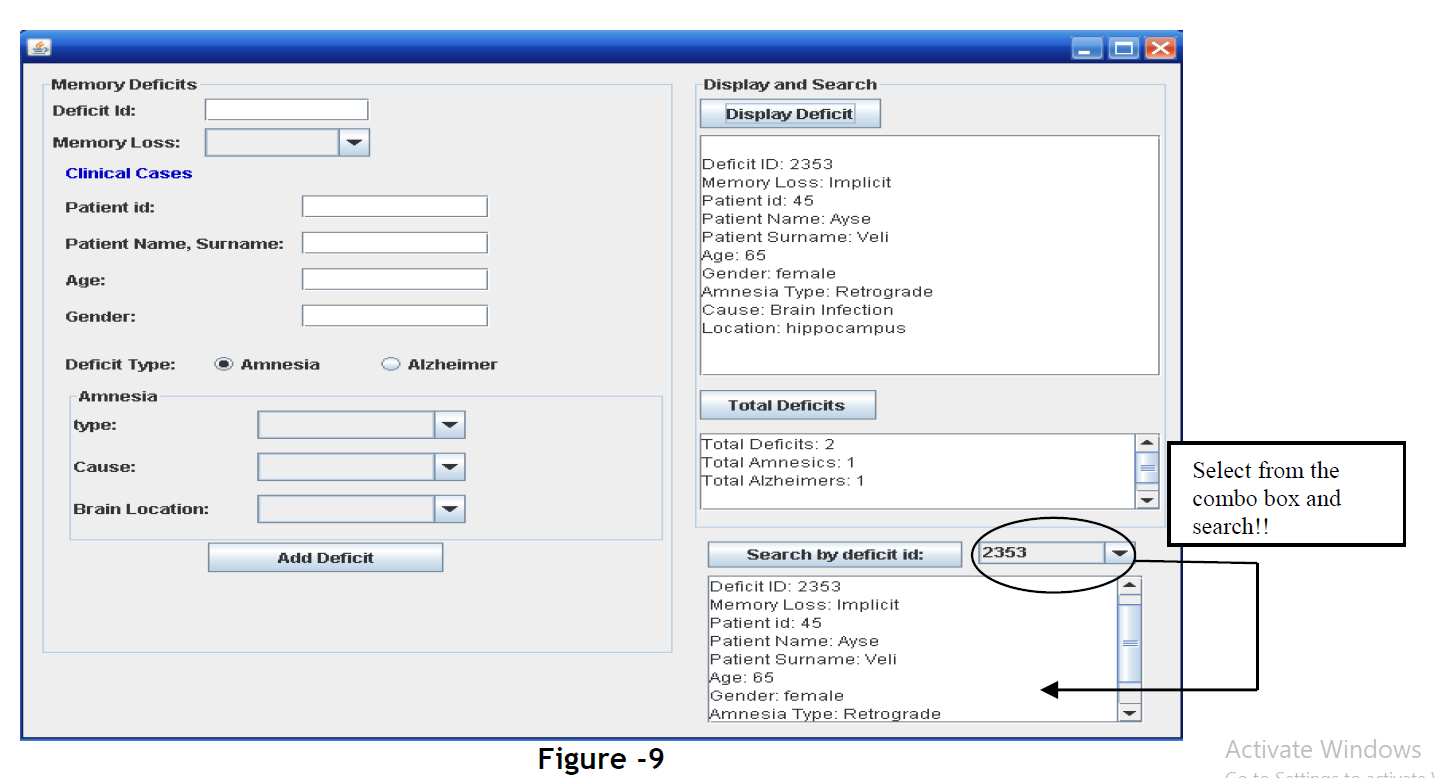
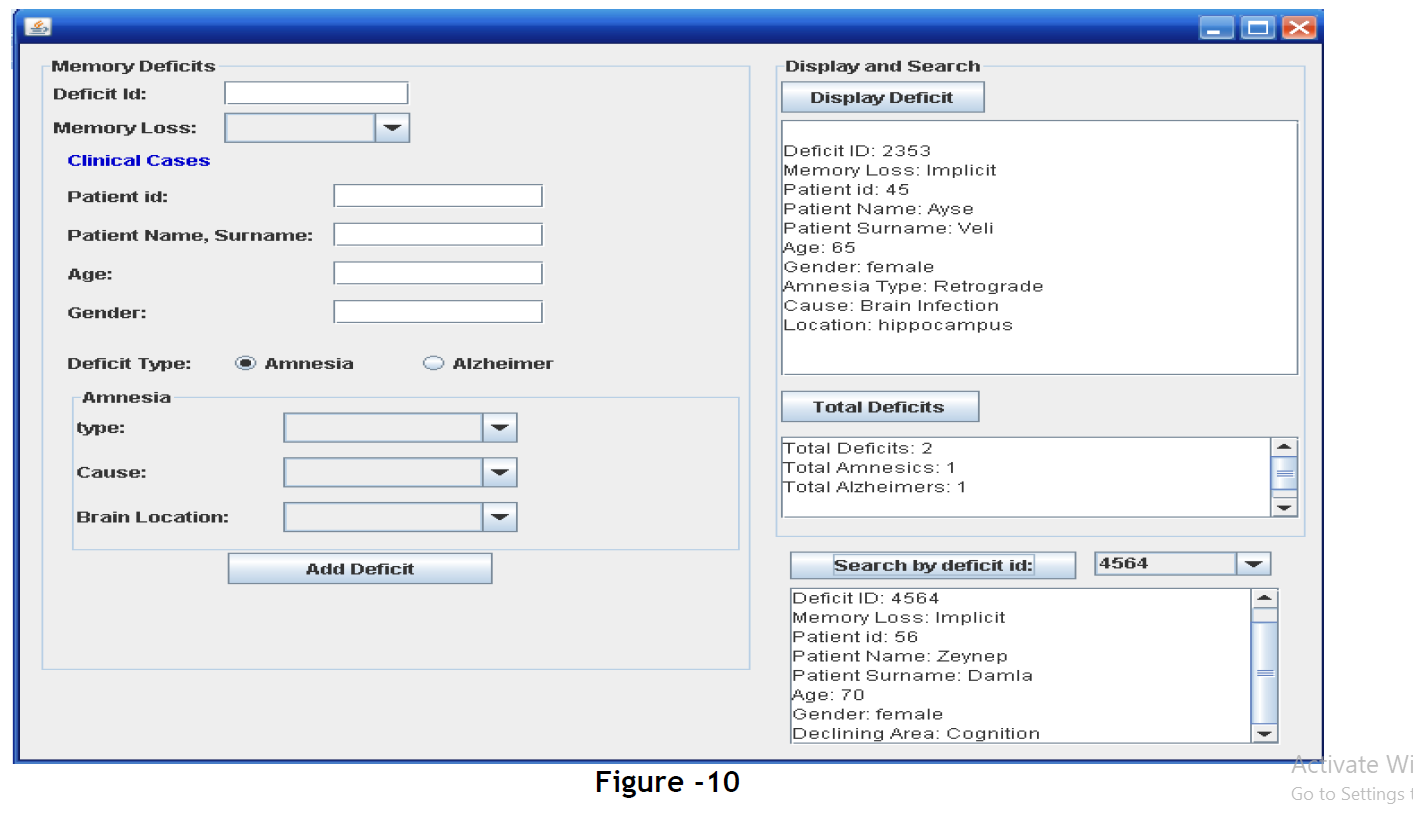
PART A: Implement your classes!! Your objective is to implement a program to understand the memory deficits of the clinical cases. Memory Deficit is divided into two parts as Alzheimer and Amnesia. Alzheimer and Amnesia are all memory deficits. Each has its own patient/s or we can just call them as clinical cases. Improvement > + improveMemory(): String Java Class Diagram: MemoryDeficit (abstract) #deficit_id: String #memory_1033: String #totalDeficit:int InfoClass +memoryArrayList:ArrayList
+addMemory (MemoryDeficit def):void +getAll Memory (: String +getAmnesia (): String +getAlzheimer (): String searchMemory (String id) : MemoryDeficit +showTotalMemory(): String + showImprovement (): String +MemoryDeficit (String, String) +toString(): String +get TotalDeficit ):int +get Deficit id (): String Alzheimer -declining area: String -TARTAlzheimering -clin: ClinicalCase Amnesia -amnesia type: String -cause: String - location: String -clin: Sinisataas -totalAmnesia: Int +Alzheimer (String String String String.String. Stringate String) +toString(): String +ges TotalAlzheimex.) : int + +Amnesia (String, String String, String, String.String. String String intString) +toString(): String +geclotalAmnesia () :int ClinicalCase -patient id: String -nadiensname: String -patient surname : String - -gender:String + ClinicalCase (String, String, String, int. String) + String): String +get Patient id:String Relationships between classes: There is an IS-A Relationship between the classes MemoryDeficit, Alzheimer and Amnesia that can be seen from the class diagram. There is a HAS-A Relationship between Alzheimer and ClinicalCase classes and a HAS-A Relationship between Amnesia and ClinicalCase classes Implement your classes according to these important notifications given above. Some information related with classes: For all non-visual classes, there is no default value for the non-static data members. Write only the necessary accessor and mutator methods inside the classes!! You may add methods other than the given ones, If you are going to use them!! toString() method for all the classes: will return the necessary data field information related with the implemented class. improveMemory() method is overridden in child classes (Alzheimer and Amnesia). For Alzheimer, returns "Solve Sudoku puzzles!" For Amnesia, it returns "Look old photos!". PART B: Implement your GUI!! . Create a frame in your project named as MemoryApp. Frame-1: This frame is the default start up frame. At first, users will enter the id of the deficit and choose the type of the memory loss from the combo box. Then, the user will enter the information of the clinical cases representing the patients. Be careful while entering the name and surname of the patient. Do not forget to separate them by using comma (,) after getting from the user. The deficit type divided into two parts as Amnesia and Alzheimer. Use radio buttons to differentiate them and to open related panels. You may use different number of panels, however do not forget to implement the ones which have the titled border. User cannot edit text areas. Display and Search #Alguy Thefill Memory DORO Delut : Clinic CHI Pald: Patient Name Surname Age Gender min) Alzheimer Dulce Type Amosia type: Tuta Dulc The Le Add Duct Searen ty Tori Figure -1 3 Figure -2 and 3: Enter the necessary information, choose the radio button "Amnesia" in order to enter information about this type of memory deficit. "ADD DEFICIT" button for "Amnesia": When the user presses "ADD DEFICIT" button, the information about the memory deficit "Amnesia" must be kept from the necessary components. You will create an Amnesia object with using these information. Then, you will add that object into the InfoClass's ArrayList without creating an InfoClass Object (try to use InfoClass's addMemory method). Also before the add operation ended, all the necessary text fields must be cleared and the combo box values must be appeared as empty just like the opening frame. The added "Amnesia" must be send to the first text area as a message of "Amnesia is added". The value of the "deficit id" will be sent to another combo box at the right side of the frame, next to the "Search by deficit id" button. > BE CAREFUL; USE ONLY ONE ARRAYLIST which blongs to the InfoClass's static one for holding memory deficit information. DO NOT TRY to separate them into two array lists. DS terwyl Dec 0:53 Hemory.pl Ondan Pain Pote, Suraw Patient Sew 5 Grad AL Tourer Figure -2 Figure - 3 Figure -4 and 5: Enter the necessary information; choose the radio button "Alzheimer" in order to enter information about this type of memory deficit. "ADD DEFICIT" button for "Alzheimer": When the user presses "ADD DEFICIT" button, the information about the memory deficit "Alzheimer" must be kept from the necessary components. You will create an Alzheimer object with using these information. Then, you will add that object into the InfoClass's ArrayList without creating an InfoClass Object (try to use InfoClass's addMemory method). Also before the add operation ended, all the necessary text fields must be cleared and the combo box values must be appeared as empty just like the opening frame. The added "Alzheimer" must be send to the first text area as a message of "Alzheimer is added". 4 The value of the "deficit id" will be sent to another combo box at the right side of the frame, next to the "Search by deficit id" button. De WY | Disd| try plor) Merry Pem, Deicherweise Hotels Med A w Sewch eich 1561 Figure -4 Figure -5 Figure -6-7: Display Deficit button: in order to display information about the memory deficit types use "Display Deficit" button. You are supposed to use InfoClass's getAllMemory() method. . . Use radio buttons to differentiate the memory deficit types. If the user selects "Amnesia" radio button and presses the Display Deficit" button, all the information about this deficit type will be displayed. You are supposed to use InfoClass's static getAmnesia() method to do this. ya CEI CARR ply wisdom Depo Dutch Smer Lorpet DARIUS Potr 43 Patient Ourname Vest Part No. S Amnei TVR an Nippon - AL A Testade At Maar Figure -6 If the user selects "Alzheimer" radio button and presses the "Display Deficit" button, all the information about this deficit type will be displayed. You are supposed to use InfoClass's static getAlzheimer() method to do this. Be careful, "display deficit" button will display all the amnesia information or all the Alzheimer information hold in the array list. 5 Merry Dw Deficit : Momory Loss Dix Sech Deslav Dulu Patient in Power, AR: : Currear: : Daticit ID: Sud Memory I'm Patient Name: Zeynep rouent Gurname Damla W rame bomia onder female Declining Ares Cognition Ar Dort TV Azon Azer Total Dutt um+Eted turns: AN DET ER Figure - 7 Figure - 8: Total Deficits button: When the user presses "Total Deficits" button, in the second text area the information about the total numbers of Total Deficits", "Total Amnesics" and "Total Alzheimers" will be appeared. You are supposed to use InfoClass's showTotalMemory() method which calls the MemoryDeficit class's static method of getTotalDeficit(). If you need similar static methods for the other total values, add them too. Since, we just entered two information, the number of Total Deficits" is 2, "Total Amnesics" is 1 and the number of "Total Alzheimers" is 1. For every added memory deficit whether "Amnesia" or "Alzheimer", the values here must be increment. Merry Dutt Display and Such Diply Duck Memory Loss Cilik CARIN Patient : Patient Name Surname Age: DonctID: 4984 Momory LOGG: Implicit Patient id: 66 Patient Name: Zeynep Patient Surname Dwmi AD TO Blender Temale Declining Area: Cognition Amesa Azer Den Type: Alam Arrected Area: Total Du Totalci > Tots Arc Total Alzheimer. 1 Ad Duhet Search by den 2353 Figure - 8 6 Figure -9-10: Search by deficit id button: The users can search both memory deficit types by using the deficit ids. Your search process will be done by InfoClass's static method of search Memory() which requires a string id as a parameter. When the user selects an id from the combo box and presses the "Search by deficit id" button, the information about that deficit, should appear in the text area. Display on me Digital Memy Ducis Deficit Memory Loss Clinical Putet Pati Nari, Summer A: Deficit 53 Memory LORS: Implicit Patient id: 45 Patent Name: Patient Surname Ve Age: Ganderem Amnesia Type: Rotrograde Care Brain Infection Location: hippocampus esane vee Gender: Armeria Alzheimer Dock Type: Amnesia Total Dulles Cause Total Du Total Anno: 1 Total Alzheimers: 1 Brain Location Select from the combo box and search!! 29 Acid Derick Duct ID: 2232 Memory Loco: implicit Parid: 45 Patient Name: Ase Patient Surname: Veli Age 60 Bender female Amnesia Tyne Retrograda Figure - 9 Memory Deficit Deficit let: Display and Search Display Deficit Memory : Clinical Cases Patient i Patient Name Surname Dec ID: 2353 Memory LODG: Implicit Patient id: 45 Patient Name: Arse Patient Surnarne Veli Ayu 36 Gender: female Amnesia Type: Retrograde Cause Brain infection Location: hippocampus Age: Gender Amnesia Alzheimer Deficit Type: Amnesia ype: Total Deficits Total Del 2 TORI Amnesis 1 Total Alzheimers: 1 Caun) Brain Location: Add Deficit 45 Search try deficit id: Deficit ib: 4564 Memory Los: Implicit Punti Patiert Hara Patient Surname Damia Age: 70 Gender: female Declining Area: Cognition Figure - 10 7 Memory Deficits Display and Search Display Deficit Deficit Id: Memory Loss: Clinical Cases Patient id: Patient Name, Surname: Age: Gender: Deficit Type: O Amnesia O Alzheimer Amnesia Total Deficits type: Cause: Brain Location: Add Deficit Search by deficit id: X Memory Deficits Deficit Id: 2353 Display and Search Display Deficit Memory Loss: Implicit Clinical Cases Patient id: 45 Patient Name, Surname: Ayse, Veli Age: 65 Gender: female Deficit Type: : Amnesia Alzheimer Amnesia Total Deficits Type: : Retrograde Cause: Brain Infection Brain Location: hippocampus Add Deficit Search by deficitid Figure -2 Memory Deficits Display and Search Display Deficit Deficit Id: Memory Loss: Amnesia is added Clinical Cases Patient id: Patient Name, Surname: Age: NI dender: Deficit Type: Amnesia Alzheimer Amnesia Total Deficits type: Cause: Brain Location: Au Deficit Search wydeficii 2353 AL 00 Figure -3 Memory Deficits Deficit Id: 4564 Display and Search Display Deficit Amnesia is added Memory Loss: Implicit Clinical Cases Patient id: 56 Patient Name, Surname: Zeynep, Damla Age: 70 Gender: female Amnesia Alzheimer Deficit Type: Alzheimer Total Deficits Affected Area: Cognition Add Deficit Search by deficit id: 2353 Figure -4 X Memory Deficits Deficit la: Display and Search Display Deficit Memory Loss: Amnesia is added Alzheimer is added Clinical Cases Patient id: IN Patient Name Surname: Age: Gender: Amnesia Alzheimer Deficit Type: Alzheimer Total Deficits Affected Area Add Deficit Search by deficit id: 2353 2353 4564 Figure -5 A Display and Search Display Deficit Memory Deficits Dericit le: Memory Loss: Clinical Cases Patient ici: Patient Name, Surname: Dericit ID: 2363 Memory Loss: implicit Patient id: 45 Patient Name: Ayse Patient Surname: Veli Age: 66 Gender: female Amnesia Type: Retrograde Cause: Brain Infection Location: hippocampus Age: Gender: Dericit Type: O Alzheimer Amnesia Total Deficits type: Cause: Brain Location: Add Dericit Search by deficit id: 2353 Figure -6 Memory Deficits Deficit Id: Display and Search Display Deficit Memory Loss: Clinical Cases Patient id: Deficit ID: 4564 Memory Loss: Implicit Patient id: 56 Patient Name: Zeynep Palleril surriarre. Darrila Age: 70 Gender: female Declining Area: Cognition Patient Name, Surname: Age: Gender: Amnesia O Alzheimer Deficit Type: Alzheimer Tutal Dericils Affected Area: Add Deficit Search by deficit id: 2353 Figure - 7 Activate Wind Go to Settings to a Memory Deficits Deficit Id: Display and Search Display Deficit Memory Loss: Clinical Cases Patient id: Deficit ID: 4564 Memory Loss: Implicit Patient id: 56 Patient Name: Zeynep Patient Surname: Damla Age: 70 Gender: female Declining Area: Cognition Patient Name, Surname: Age: Gender: Amnesia O Alzheimer Deficit Type: : Alzheimer Total Deficits Affected Area: Total Deficits: 2 Total Amnesics: 1 Total Alzheimers: 1 Add Deficit Search by deficit id: 2353 Figure - 8 Memory Deficits Deficit Id: Display and Search Display Deficit Memory Loss: Clinical Cases Patient id: Patient Name, Surname: Deficit ID: 2353 Memory Loss: Implicit Patient id: 45 Patient Name: Ayse Patient Surname: Veli Age: 65 Gender: female Amnesia Type: Retrograde Cause: Brain Infection Location: hippocampus Age: Gender: Deficit Type: O Amnesia O Alzheimer Amnesia Total Deficits type: Cause: Total Deficits: 2 Total Amnesics 1 Total Alzheimers: 1 Select from the combo box and search!! Brain Location: Add Deficit Search by deficit id: 2353 Deficit ID: 2353 Memory Loss: Implicit Patient id: 45 Patient Name: Ayse Patient Surname: Veli Age: 65 Gender: female Amnesia Type: Retrograde Activate Windows Figure - 9 Memory Deficits Display and Search Deficit Id: Display Deficit Memory Loss: Clinical Cases Patient id: Patient Name, Surname: Deficit ID: 2353 Memory Loss: Implicit Patient id: 45 Patient Name: Ayse Patient Surname: Veli Age: 65 Gender: female Amnesia Type: Retrograde Cause: Brain Infection Location: hippocampus Age: Gender: Deficit Type: O Amnesia O Alzheimer Amnesia Total Deficits type: Cause: Total Deficits: 2 Total Amnesics: 1 Total Alzheimers: 1 Brain Location: Add Deficit Search by deficit id: 4564 Deficit ID: 4564 Memory Loss: Implicit Patient id: 56 Patient Name: Zeynep Patient Surname: Damla Age: 70 Gender: female Declining Area: Cognition ) Figure - 10 Activate Wi Go to Settings PART A: Implement your classes!! Your objective is to implement a program to understand the memory deficits of the clinical cases. Memory Deficit is divided into two parts as Alzheimer and Amnesia. Alzheimer and Amnesia are all memory deficits. Each has its own patient/s or we can just call them as clinical cases. Improvement > + improveMemory(): String Java Class Diagram: MemoryDeficit (abstract) #deficit_id: String #memory_1033: String #totalDeficit:int InfoClass +memoryArrayList:ArrayList +addMemory (MemoryDeficit def):void +getAll Memory (: String +getAmnesia (): String +getAlzheimer (): String searchMemory (String id) : MemoryDeficit +showTotalMemory(): String + showImprovement (): String +MemoryDeficit (String, String) +toString(): String +get TotalDeficit ):int +get Deficit id (): String Alzheimer -declining area: String -TARTAlzheimering -clin: ClinicalCase Amnesia -amnesia type: String -cause: String - location: String -clin: Sinisataas -totalAmnesia: Int +Alzheimer (String String String String.String. Stringate String) +toString(): String +ges TotalAlzheimex.) : int + +Amnesia (String, String String, String, String.String. String String intString) +toString(): String +geclotalAmnesia () :int ClinicalCase -patient id: String -nadiensname: String -patient surname : String - -gender:String + ClinicalCase (String, String, String, int. String) + String): String +get Patient id:String Relationships between classes: There is an IS-A Relationship between the classes MemoryDeficit, Alzheimer and Amnesia that can be seen from the class diagram. There is a HAS-A Relationship between Alzheimer and ClinicalCase classes and a HAS-A Relationship between Amnesia and ClinicalCase classes Implement your classes according to these important notifications given above. Some information related with classes: For all non-visual classes, there is no default value for the non-static data members. Write only the necessary accessor and mutator methods inside the classes!! You may add methods other than the given ones, If you are going to use them!! toString() method for all the classes: will return the necessary data field information related with the implemented class. improveMemory() method is overridden in child classes (Alzheimer and Amnesia). For Alzheimer, returns "Solve Sudoku puzzles!" For Amnesia, it returns "Look old photos!". PART B: Implement your GUI!! . Create a frame in your project named as MemoryApp. Frame-1: This frame is the default start up frame. At first, users will enter the id of the deficit and choose the type of the memory loss from the combo box. Then, the user will enter the information of the clinical cases representing the patients. Be careful while entering the name and surname of the patient. Do not forget to separate them by using comma (,) after getting from the user. The deficit type divided into two parts as Amnesia and Alzheimer. Use radio buttons to differentiate them and to open related panels. You may use different number of panels, however do not forget to implement the ones which have the titled border. User cannot edit text areas. Display and Search #Alguy Thefill Memory DORO Delut : Clinic CHI Pald: Patient Name Surname Age Gender min) Alzheimer Dulce Type Amosia type: Tuta Dulc The Le Add Duct Searen ty Tori Figure -1 3 Figure -2 and 3: Enter the necessary information, choose the radio button "Amnesia" in order to enter information about this type of memory deficit. "ADD DEFICIT" button for "Amnesia": When the user presses "ADD DEFICIT" button, the information about the memory deficit "Amnesia" must be kept from the necessary components. You will create an Amnesia object with using these information. Then, you will add that object into the InfoClass's ArrayList without creating an InfoClass Object (try to use InfoClass's addMemory method). Also before the add operation ended, all the necessary text fields must be cleared and the combo box values must be appeared as empty just like the opening frame. The added "Amnesia" must be send to the first text area as a message of "Amnesia is added". The value of the "deficit id" will be sent to another combo box at the right side of the frame, next to the "Search by deficit id" button. > BE CAREFUL; USE ONLY ONE ARRAYLIST which blongs to the InfoClass's static one for holding memory deficit information. DO NOT TRY to separate them into two array lists. DS terwyl Dec 0:53 Hemory.pl Ondan Pain Pote, Suraw Patient Sew 5 Grad AL Tourer Figure -2 Figure - 3 Figure -4 and 5: Enter the necessary information; choose the radio button "Alzheimer" in order to enter information about this type of memory deficit. "ADD DEFICIT" button for "Alzheimer": When the user presses "ADD DEFICIT" button, the information about the memory deficit "Alzheimer" must be kept from the necessary components. You will create an Alzheimer object with using these information. Then, you will add that object into the InfoClass's ArrayList without creating an InfoClass Object (try to use InfoClass's addMemory method). Also before the add operation ended, all the necessary text fields must be cleared and the combo box values must be appeared as empty just like the opening frame. The added "Alzheimer" must be send to the first text area as a message of "Alzheimer is added". 4 The value of the "deficit id" will be sent to another combo box at the right side of the frame, next to the "Search by deficit id" button. De WY | Disd| try plor) Merry Pem, Deicherweise Hotels Med A w Sewch eich 1561 Figure -4 Figure -5 Figure -6-7: Display Deficit button: in order to display information about the memory deficit types use "Display Deficit" button. You are supposed to use InfoClass's getAllMemory() method. . . Use radio buttons to differentiate the memory deficit types. If the user selects "Amnesia" radio button and presses the Display Deficit" button, all the information about this deficit type will be displayed. You are supposed to use InfoClass's static getAmnesia() method to do this. ya CEI CARR ply wisdom Depo Dutch Smer Lorpet DARIUS Potr 43 Patient Ourname Vest Part No. S Amnei TVR an Nippon - AL A Testade At Maar Figure -6 If the user selects "Alzheimer" radio button and presses the "Display Deficit" button, all the information about this deficit type will be displayed. You are supposed to use InfoClass's static getAlzheimer() method to do this. Be careful, "display deficit" button will display all the amnesia information or all the Alzheimer information hold in the array list. 5 Merry Dw Deficit : Momory Loss Dix Sech Deslav Dulu Patient in Power, AR: : Currear: : Daticit ID: Sud Memory I'm Patient Name: Zeynep rouent Gurname Damla W rame bomia onder female Declining Ares Cognition Ar Dort TV Azon Azer Total Dutt um+Eted turns: AN DET ER Figure - 7 Figure - 8: Total Deficits button: When the user presses "Total Deficits" button, in the second text area the information about the total numbers of Total Deficits", "Total Amnesics" and "Total Alzheimers" will be appeared. You are supposed to use InfoClass's showTotalMemory() method which calls the MemoryDeficit class's static method of getTotalDeficit(). If you need similar static methods for the other total values, add them too. Since, we just entered two information, the number of Total Deficits" is 2, "Total Amnesics" is 1 and the number of "Total Alzheimers" is 1. For every added memory deficit whether "Amnesia" or "Alzheimer", the values here must be increment. Merry Dutt Display and Such Diply Duck Memory Loss Cilik CARIN Patient : Patient Name Surname Age: DonctID: 4984 Momory LOGG: Implicit Patient id: 66 Patient Name: Zeynep Patient Surname Dwmi AD TO Blender Temale Declining Area: Cognition Amesa Azer Den Type: Alam Arrected Area: Total Du Totalci > Tots Arc Total Alzheimer. 1 Ad Duhet Search by den 2353 Figure - 8 6 Figure -9-10: Search by deficit id button: The users can search both memory deficit types by using the deficit ids. Your search process will be done by InfoClass's static method of search Memory() which requires a string id as a parameter. When the user selects an id from the combo box and presses the "Search by deficit id" button, the information about that deficit, should appear in the text area. Display on me Digital Memy Ducis Deficit Memory Loss Clinical Putet Pati Nari, Summer A: Deficit 53 Memory LORS: Implicit Patient id: 45 Patent Name: Patient Surname Ve Age: Ganderem Amnesia Type: Rotrograde Care Brain Infection Location: hippocampus esane vee Gender: Armeria Alzheimer Dock Type: Amnesia Total Dulles Cause Total Du Total Anno: 1 Total Alzheimers: 1 Brain Location Select from the combo box and search!! 29 Acid Derick Duct ID: 2232 Memory Loco: implicit Parid: 45 Patient Name: Ase Patient Surname: Veli Age 60 Bender female Amnesia Tyne Retrograda Figure - 9 Memory Deficit Deficit let: Display and Search Display Deficit Memory : Clinical Cases Patient i Patient Name Surname Dec ID: 2353 Memory LODG: Implicit Patient id: 45 Patient Name: Arse Patient Surnarne Veli Ayu 36 Gender: female Amnesia Type: Retrograde Cause Brain infection Location: hippocampus Age: Gender Amnesia Alzheimer Deficit Type: Amnesia ype: Total Deficits Total Del 2 TORI Amnesis 1 Total Alzheimers: 1 Caun) Brain Location: Add Deficit 45 Search try deficit id: Deficit ib: 4564 Memory Los: Implicit Punti Patiert Hara Patient Surname Damia Age: 70 Gender: female Declining Area: Cognition Figure - 10 7 Memory Deficits Display and Search Display Deficit Deficit Id: Memory Loss: Clinical Cases Patient id: Patient Name, Surname: Age: Gender: Deficit Type: O Amnesia O Alzheimer Amnesia Total Deficits type: Cause: Brain Location: Add Deficit Search by deficit id: X Memory Deficits Deficit Id: 2353 Display and Search Display Deficit Memory Loss: Implicit Clinical Cases Patient id: 45 Patient Name, Surname: Ayse, Veli Age: 65 Gender: female Deficit Type: : Amnesia Alzheimer Amnesia Total Deficits Type: : Retrograde Cause: Brain Infection Brain Location: hippocampus Add Deficit Search by deficitid Figure -2 Memory Deficits Display and Search Display Deficit Deficit Id: Memory Loss: Amnesia is added Clinical Cases Patient id: Patient Name, Surname: Age: NI dender: Deficit Type: Amnesia Alzheimer Amnesia Total Deficits type: Cause: Brain Location: Au Deficit Search wydeficii 2353 AL 00 Figure -3 Memory Deficits Deficit Id: 4564 Display and Search Display Deficit Amnesia is added Memory Loss: Implicit Clinical Cases Patient id: 56 Patient Name, Surname: Zeynep, Damla Age: 70 Gender: female Amnesia Alzheimer Deficit Type: Alzheimer Total Deficits Affected Area: Cognition Add Deficit Search by deficit id: 2353 Figure -4 X Memory Deficits Deficit la: Display and Search Display Deficit Memory Loss: Amnesia is added Alzheimer is added Clinical Cases Patient id: IN Patient Name Surname: Age: Gender: Amnesia Alzheimer Deficit Type: Alzheimer Total Deficits Affected Area Add Deficit Search by deficit id: 2353 2353 4564 Figure -5 A Display and Search Display Deficit Memory Deficits Dericit le: Memory Loss: Clinical Cases Patient ici: Patient Name, Surname: Dericit ID: 2363 Memory Loss: implicit Patient id: 45 Patient Name: Ayse Patient Surname: Veli Age: 66 Gender: female Amnesia Type: Retrograde Cause: Brain Infection Location: hippocampus Age: Gender: Dericit Type: O Alzheimer Amnesia Total Deficits type: Cause: Brain Location: Add Dericit Search by deficit id: 2353 Figure -6 Memory Deficits Deficit Id: Display and Search Display Deficit Memory Loss: Clinical Cases Patient id: Deficit ID: 4564 Memory Loss: Implicit Patient id: 56 Patient Name: Zeynep Palleril surriarre. Darrila Age: 70 Gender: female Declining Area: Cognition Patient Name, Surname: Age: Gender: Amnesia O Alzheimer Deficit Type: Alzheimer Tutal Dericils Affected Area: Add Deficit Search by deficit id: 2353 Figure - 7 Activate Wind Go to Settings to a Memory Deficits Deficit Id: Display and Search Display Deficit Memory Loss: Clinical Cases Patient id: Deficit ID: 4564 Memory Loss: Implicit Patient id: 56 Patient Name: Zeynep Patient Surname: Damla Age: 70 Gender: female Declining Area: Cognition Patient Name, Surname: Age: Gender: Amnesia O Alzheimer Deficit Type: : Alzheimer Total Deficits Affected Area: Total Deficits: 2 Total Amnesics: 1 Total Alzheimers: 1 Add Deficit Search by deficit id: 2353 Figure - 8 Memory Deficits Deficit Id: Display and Search Display Deficit Memory Loss: Clinical Cases Patient id: Patient Name, Surname: Deficit ID: 2353 Memory Loss: Implicit Patient id: 45 Patient Name: Ayse Patient Surname: Veli Age: 65 Gender: female Amnesia Type: Retrograde Cause: Brain Infection Location: hippocampus Age: Gender: Deficit Type: O Amnesia O Alzheimer Amnesia Total Deficits type: Cause: Total Deficits: 2 Total Amnesics 1 Total Alzheimers: 1 Select from the combo box and search!! Brain Location: Add Deficit Search by deficit id: 2353 Deficit ID: 2353 Memory Loss: Implicit Patient id: 45 Patient Name: Ayse Patient Surname: Veli Age: 65 Gender: female Amnesia Type: Retrograde Activate Windows Figure - 9 Memory Deficits Display and Search Deficit Id: Display Deficit Memory Loss: Clinical Cases Patient id: Patient Name, Surname: Deficit ID: 2353 Memory Loss: Implicit Patient id: 45 Patient Name: Ayse Patient Surname: Veli Age: 65 Gender: female Amnesia Type: Retrograde Cause: Brain Infection Location: hippocampus Age: Gender: Deficit Type: O Amnesia O Alzheimer Amnesia Total Deficits type: Cause: Total Deficits: 2 Total Amnesics: 1 Total Alzheimers: 1 Brain Location: Add Deficit Search by deficit id: 4564 Deficit ID: 4564 Memory Loss: Implicit Patient id: 56 Patient Name: Zeynep Patient Surname: Damla Age: 70 Gender: female Declining Area: Cognition ) Figure - 10 Activate Wi Go to Settings






















